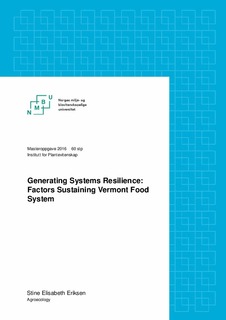| dc.description.abstract | This case study explores key elements that must act for sustaining LFS in communities, using a case study from Vermont. Rooted in community-based and direct-marketing sales, the LFS in Vermont was a result of new market interactions formed in the 1970’s. Since then, consumers demand for transparency and quality food has expanded and local food is increasingly offered at public institutions, supermarkets and local restaurants across the state of Vermont. As LFS has gained momentum in policy and the marketplace, this research looks at the role of collective efforts, and key drivers that sustain the LFS. As demand for social, economic and environmentally responsible food increase, this case study explores the way collective efforts can play a major role in facilitating for sustainable food system change. | nb_NO |

